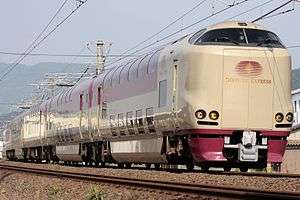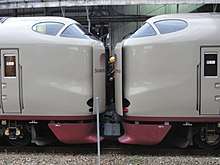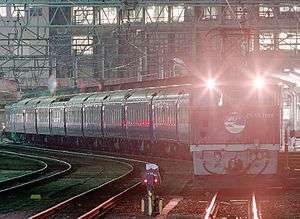Sunrise Seto
 285 series EMU on a Sunrise Seto service, May 2009 | |
| Overview | |
|---|---|
| Service type | Limited express |
| Status | Operational |
| Locale | Japan |
| Predecessor | Seto |
| First service | 10 July 1998 |
| Current operator(s) | JR Central, JR West |
| Route | |
| Start | Tokyo |
| End | Takamatsu |
| Distance travelled | 804.7 km (500.0 mi) |
| Average journey time | approx. 9 hours 30 minutes |
| Service frequency | 1 return working daily |
| On-board services | |
| Seating arrangements | None |
| Sleeping arrangements | Private compartments/open-plan sleeping areas |
| Catering facilities | None |
| Technical | |
| Rolling stock | 285 series EMUs |
| Track gauge | 1,067 mm (3 ft 6 in) |
| Electrification | 1,500 V DC |
| Operating speed | 130 km/h (80 mph) |
The Sunrise Seto (サンライズ瀬戸 Sanraizu Seto) is an overnight sleeping car train service in Japan operated jointly by Central Japan Railway Company (JR Central) and West Japan Railway Company (JR West) since July 1998.[1][2]
Operations
The Sunrise Seto runs daily between Tokyo and Takamatsu in Kagawa Prefecture on the island of Shikoku, taking about 9 hours 30 minutes for the 804.7 km (500.0 mi) journey.[2] The service operates in conjunction with the Sunrise Izumo service to Izumoshi between Tokyo and Okayama. The combined 14-car train departs from Tokyo, and stops at Yokohama, Atami, Numazu, Fuji, Shizuoka, Hamamatsu (final midnight stop), Himeji (first morning stop), and arrives at Okayama, where the train splits, with the Sunrise Izumo half of the train heading to Izumoshi.[3] Between Okayama and Takamatsu, the 7-car Sunrise Seto train stops at Kojima and Sakaide, before arriving in Takamatsu. The return train departs from Takamatsu, and is coupled with the Sunrise Izumo from Izumoshi at Okayama Station, departing together from there, and arriving at Tokyo Station in the next morning.
There are seasonal extended services which Sunrise Seto trains from Tokyo run beyond Takamatsu, to Kotohira on the Dosan Line. These extended service trains run during particular seasons (Differs each year), and during the holidays.
- A Sunrise Seto & Sunrise Izumo combined formation on the Sanyo Main Line, May 2012
 Sunrise Izumo and Sunrise Seto units being uncoupled at Okayama Station, March 2013
Sunrise Izumo and Sunrise Seto units being uncoupled at Okayama Station, March 2013 Destination indicator for a Tokyo-bound service
Destination indicator for a Tokyo-bound service
Station list
| Station | Distance (km) | Time[3] | Location | ||||
|---|---|---|---|---|---|---|---|
| Name | Japanese | Between
stations |
From
Tokyo |
Westbound
(-> Takamatsu) |
Eastbound
(-> Tokyo) |
Ward / City | Prefecture /
Metropolis |
| Tokyo | 東京 | - | 0.0 | 22:00 Departure | 07:08 Arrival | Chiyoda | Tokyo |
| Yokohama | 横浜 | 22.0 | 28.8 | 22:23 Arrival
22:24 Departure |
06:44 Arrival
06:45 Departure |
Yokohama | Kanagawa |
| Atami | 熱海 | 20.7 | 104.6 | 23:21 Arrival
23:23 Departure |
05:43 Arrival
05:45 Departure |
Atami | Shizuoka |
| Numazu | 沼津 | 21.6 | 126.2 | 23:39 Arrival
23:40 Departure |
05:26 Arrival
05:27 Departure |
Numazu | |
| Fuji | 富士 | 20.0 | 146.2 | 23:53 Arrival
23:54 Departure |
05:09 Arrival
05:10 Departure |
Fuji | |
| Shizuoka | 静岡 | 34.0 | 180.2 | 00:19 Arrival
00:20 Departure |
04:38 Arrival
04:40 Departure |
Shizuoka | |
| Hamamatsu | 浜松 | 76.9 | 257.1 | 01:11 Arrival
01:12 Departure |
↑
(Brief stop) |
Hamamatsu | |
| Toyohashi | 豊橋 | 36.5 | 293.6 | (Brief stop) | Toyohashi | Aichi | |
| Nagoya | 名古屋 | 72.4 | 366.0 | ↓ | ↑
(Brief stop) |
Nagoya | |
| Gifu | 岐阜 | 30.3 | 396.3 | ↓
(Brief stop) |
↑ | Gifu | Gifu |
| Maibara | 米原 | 49.6 | 445.9 | (Brief stop) | Maibara | Shiga | |
| Ōsaka | 大阪 | 110.5 | 556.4 | ↓
(Brief stop) |
00:32 Arrival
00:34 Departure |
Osaka | Osaka |
| Sannomiya | 三ノ宮 | 30.6 | 587.0 | ↓ | 00:12 Arrival
00:13 Departure |
Kobe | Hyogo |
| Himeji | 姫路 | 57.3 | 644.3 | 05:25 Arrival
05:26 Departure |
23:33 Arrival
23:35 Departure |
Himeji | |
| Okayama | 岡山 | 88.6 | 732.9 | 06:27 Arrival
(Decouple and separate from Sunrise Izumo) 06:31 Departure |
22:23 Arrival
(Couple with Sunrise Izumo) 22:34 Departure |
Okayama | Okayama |
| Kojima | 児島 | 27.8 | 760.7 | 06:52 Arrival
06:53 Departure |
22:00 Arrival
22:01 Departure |
Kurashiki | |
| Sakaide | 坂出 | 22.7 | 783.4 | 07:09 Arrival
07:10 Departure |
21:44 Arrival
21:45 Departure |
Sakaide | Kagawa |
| Takamatsu | 高松 | 21.3 | 804.7 | 07:27 Arrival | 21:26 Departure | Takamatsu | |
| Seasonal extended services (from Tokyo) to Kotohira | |||||||
| Takamatsu | 高松 | - | 804.7 | 07:54 Departure | / | Takamatsu | Kagawa |
| Tadotsu | 多度津 | 32.7 | 837.4 | 08:33 Arrival
08:35 Departure |
Tadotsu | ||
| Zentsūji | 善通寺 | 6.0 | 843.4 | 08:43 Arrival
08:45 Departure |
Zentsuji | ||
| Kotohira | 琴平 | 5.3 | 848.7 | 08:52 Arrival | Kotohira | ||
- Trains make brief stops for several reasons, here being crew changes at JR region boundaries. Passengers cannot board or get off the train when it makes such stops.
Formation
Trains are formed of dedicated 7-car 285 series Sunrise Express electric multiple units (EMUs) owned by both JR Central and JR West. They are formed as shown below, with cars numbered 8 to 14 in the down (westbound) direction, with car 14 at the Tokyo end, and 1 to 7 in the up (Tokyo-bound) direction, with car 7 at the Tokyo end.[1]
| Car No. | 1/8 | 2/9 | 3/10 | 4/11 | 5/12 | 6/13 | 7/14 |
|---|---|---|---|---|---|---|---|
| Numbering | KuHaNe 285 | SaHaNe 285 | MoHaNe 285 | SaRoHaNe 285 | MoHaNe 285 | SaHaNe 285 | KuHaNe 285 |
| Accommodation | B single berths | B single berths | B solo berths | Single DX berths | B single berths Nobinobi floor space | B single berths | B single berths |
| B single/ single-twin berths | B single/ single-twin berths | Sunrise twin berths | B single/ single-twin berths | B single/ single-twin berths | |||
| Facilities | Mini saloon area, vending machine, shower | Vending machine |
Accommodation and fees
The Sunrise Seto consists of type "A" (Single Deluxe) and type "B" accommodation. A flat fee is charged for all compartments, regardless of starting or ending point. The other fares, the basic fare and limited express fare, are based on distance. For tourists using the Japan Rail Pass, the basic fare does not have to be paid. A shower is located in car 3/10. Passengers using the type "A" Single Deluxe compartments can use the dedicated showers in their carriage for free.
 "Single Deluxe" compartment
"Single Deluxe" compartment Car 4/11 corridor
Car 4/11 corridor Single berth
Single berth- Single-twin berth
- Nobinobi open-plan sleeping area (car 5/12, upper floor)
- Nobinobi open-plan sleeping area (car 5/12, lower floor)
 Shower cubicle (car 3/10)
Shower cubicle (car 3/10)- Mini lounge area (car 3/10)
History

The Sunrise Seto services were introduced together with the Sunrise Izumo on 10 July 1998.[5] Previously, the Seto operated as a separate "Blue train" service connecting Tokyo with Takamatsu.[6] The Sunrise Izumo was intended to attract more passengers to train transportation by introducing newly designed trains and by reducing the journey time.
Ridership on overnight trains in Japan continues to decline, and from March 2009, the Sunrise Izumo and Sunrise Seto became the only overnight sleeping car trains to operate west of Tokyo via the Tokaido Line.[7]
See also
References
- 1 2 JR新幹線&特急列車ファイル [JR Shinkansen & Limited Express Train File]. Japan: Kōtsū Shimbun. 2008. p. 124. ISBN 978-4-330-00608-6.
- 1 2 Haraguchi, Takayuki (2009). Encyclopedia of JR's Railway Cars: JR全車輌. Japan: Sekai Bunka. p. 34. ISBN 978-4-418-09905-4.
- 1 2 3 JR時刻表 [JR Timetable]. Japan: Kotsu Shimbunsha. March 2013. p. 144. EAN 4910053110334.
- ↑ JR電車編成表 2013夏 [JR EMU Formations - Summer 2013]. Japan: JRR. May 2013. p. 122. ISBN 978-4-330-37313-3.
- ↑ こだわりの新幹線&特急列車ガイド [In-depth Shinkansen & Limited Express Guide]. Japan: Ikaros Publishing. August 2000. pp. 194–195. ISBN 4-87149-284-2.
- ↑ 最新特急大カタログ [Modern Limited Express Catalogue]. Japan: JTB. November 1992. p. 110.
- ↑ Ogano, Minoru (March 2011). 新幹線・特急大図鑑2011 [Shinkansen & Limited Express Directory 2011]. Japan: JTB Publishing. p. 112. ISBN 978-4-533-08193-4.
External links
| Wikimedia Commons has media related to Sunrise Seto. |
- JR West Sunrise Izumo / Sunrise Seto (in Japanese)
.svg.png)
.svg.png)